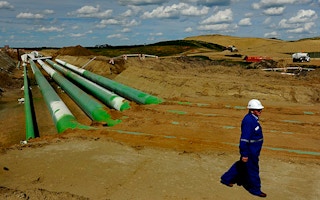EDMONTON – Calm discussion of the environment nowadays is about as plausible as reasoned dialogue on witchcraft in colonial Massachusetts. Consider the hyperbolic debate over the Keystone XL pipeline, which would funnel oil from Canada’s Athabasca tar sands in northeastern Alberta to refineries on the Texas Gulf Coast.
The Alberta government – and the oil companies that influence it – would upgrade “tar sands” to “oil sands,” apparently thinking that a better name somehow silences environmental critics. Environmentalists opposing the pipeline refer, with equal deftness, to “dirty oil.” Bystanders understandably wonder which is worse – awkward rebranding or awkward puns.
Neither gaucherie is entirely deceptive. The tar sands are hundreds of square kilometers of bitumen, a viscous and corrosive tarlike deposit. Bitumen permeates the dirt at the surface or, where thin layers of compost and sediment intervene, somewhat below basement levels. Grasping a handful of dirt from a riverbank does leave one’s hand more oily than tarred, and the greasy dirt is somewhat sandy.
This highlights the real deception by both sides. Awkwardly for oil companies, bitumen is not ordinary oil. Awkwardly for environmentalists, Nature put corrosive bitumen in the dirt. Had BP spilled hundreds of billions of barrels of bitumen across hundreds of square kilometers, environmentalists would rightly demand that no expense be spared to rid the dirt of every trace of oil. A double standard applies, because, whatever Nature does is, well, natural, and therefore good.
Environmentalists’ awkwardness is, or ought to be, disconcerting. But oil companies’ awkwardness is more substantial. They remove bitumen from the dirt in two ways. An older technology features vast strip mines, huge diggers, and trucks carting oily dirt to industrial-scale pressure cookers that drain off the bitumen. A newer technology leaves the surface untouched by pumping steam into the subsoil. This heats the bitumen, making it runny enough to be pumped out. Both processes leave toxic residues and somewhat less oily dirt.
Environmentalists make several arguments for leaving the bitumen in the dirt. They disparage hideous strip mines and toxic tailing ponds that even superstar marketers cannot “greenwash.” The scale is unusual, but open-pit mines and tailing ponds are normal mining operations everywhere. Moreover, the newer bitumen technology does without strip mines.
Environmentalists correctly note that producing heat for either process uses more energy than does overcoming gravity to pump up ordinary oil. Burning natural gas to heat oily dirt releases large amounts of carbon dioxide, exacerbating global warming. Unfortunately, biodiesel from soy is little better on this count; and California heavy oil and farm ethanol are both far worse. We are running a global experiment while living in a test tube. Given this, the oil industry’s defense – “I’m no worse a scoundrel” – seems dishonorable.
US President Barack Obama has a limited opportunity to preserve the bitumen companies’ integrity. They want to access the American market and use Gulf Coast ports to export more widely, but Keystone XL is not their only option. If Obama blocks the pipeline, they will build others, and other export facilities – if not on Canada’s environmentally delicate Pacific coast, then at some already-industrialized Atlantic port. These developments will come anyway, and, once they do, the United States will become a mere bystander. By offering conditional approval of the Keystone XL, Obama could advance the pipeline’s very genuine diplomatic and economic benefits, while reducing its environmental costs.
The benefits are huge. Flooding global markets with Canadian oil would constrain global oil prices. More important, it would advance the cause of peace. Addiction to Middle East oil distorts foreign policies, causes wars, and ravages the environment. Recall how Iraqi soldiers retreating from Kuwait in 1991 set hundreds of wellheads ablaze. The infernos spewed CO2 into the air and flaming oil across delicate desert ecosystems for months. War is not green.
America cannot realistically expect its allies – let alone countries like Iran and Venezuela, with which its relations are strained – to adopt principled foreign policies when Middle East Realpolitik distorts its own foreign policy. In the short term, Canadian oil would liberate the US from this hypocrisy. In the longer term, were shale gas and oil to satisfy US demand, Canadian oil could wean America’s allies from their Middle East oil addiction, giving them new foreign-policy options, too.
Obama’s approval should be conditional on Canada enforcing serious environmental safeguards. Many bitumen companies claim that they already abide by such safeguards; but environmentalists’ skepticism is justified. Competition presses each company to keep its costs down. Only strong regulations, transparency, and severe penalties can create a level playing field.
One obvious condition is mandatory CO2 “sequestration” (removing CO2 from the air and storing it deep underground). Mandatory sequestration could make net CO2 emissions from bitumen extraction no worse than those from conventional oil wells, and perhaps even better. Another obvious condition is mandatory timetables for restoring strip mines and tailing ponds to their natural condition.
The companies want the bitumen that Nature put in the oily dirt. Let them take it, but let’s also ensure they leave no worse a mess than Nature intended.
Randall Morck is a professor at the Alberta School of Business.
Copyright: Project Syndicate










